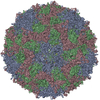+Search query
-Structure paper
| Title | Structure and Genome Release Mechanism of the Human Cardiovirus Saffold Virus 3. |
|---|---|
| Journal, issue, pages | J Virol, Vol. 90, Issue 17, Page 7628-7639, Year 2016 |
| Publish date | Sep 1, 2016 |
 Authors Authors | Edukondalu Mullapudi / Jiří Nováček / Lenka Pálková / Pavel Kulich / A Michael Lindberg / Frank J M van Kuppeveld / Pavel Plevka /    |
| PubMed Abstract | In order to initiate an infection, viruses need to deliver their genomes into cells. This involves uncoating the genome and transporting it to the cytoplasm. The process of genome delivery is not ...In order to initiate an infection, viruses need to deliver their genomes into cells. This involves uncoating the genome and transporting it to the cytoplasm. The process of genome delivery is not well understood for nonenveloped viruses. We address this gap in our current knowledge by studying the uncoating of the nonenveloped human cardiovirus Saffold virus 3 (SAFV-3) of the family Picornaviridae SAFVs cause diseases ranging from gastrointestinal disorders to meningitis. We present a structure of a native SAFV-3 virion determined to 2.5 Å by X-ray crystallography and an 11-Å-resolution cryo-electron microscopy reconstruction of an "altered" particle that is primed for genome release. The altered particles are expanded relative to the native virus and contain pores in the capsid that might serve as channels for the release of VP4 subunits, N termini of VP1, and the RNA genome. Unlike in the related enteroviruses, pores in SAFV-3 are located roughly between the icosahedral 3- and 5-fold axes at an interface formed by two VP1 and one VP3 subunit. Furthermore, in native conditions many cardioviruses contain a disulfide bond formed by cysteines that are separated by just one residue. The disulfide bond is located in a surface loop of VP3. We determined the structure of the SAFV-3 virion in which the disulfide bonds are reduced. Disruption of the bond had minimal effect on the structure of the loop, but it increased the stability and decreased the infectivity of the virus. Therefore, compounds specifically disrupting or binding to the disulfide bond might limit SAFV infection. IMPORTANCE: A capsid assembled from viral proteins protects the virus genome during transmission from one cell to another. However, when a virus enters a cell the virus genome has to be released from the capsid in order to initiate infection. This process is not well understood for nonenveloped viruses. We address this gap in our current knowledge by studying the genome release of Human Saffold virus 3 Saffold viruses cause diseases ranging from gastrointestinal disorders to meningitis. We show that before the genome is released, the Saffold virus 3 particle expands, and holes form in the previously compact capsid. These holes serve as channels for the release of the genome and small capsid proteins VP4 that in related enteroviruses facilitate subsequent transport of the virus genome into the cell cytoplasm. |
 External links External links |  J Virol / J Virol /  PubMed:27279624 / PubMed:27279624 /  PubMed Central PubMed Central |
| Methods | EM (single particle) / X-ray diffraction |
| Resolution | 2.5 - 10.6 Å |
| Structure data | EMDB-3097, PDB-5a8f:  PDB-5cfc:  PDB-5cfd: |
| Chemicals |  ChemComp-HOH: |
| Source |
|
 Keywords Keywords | VIRAL PROTEIN / SAFFOLD / VIRUS / CARDIOVIRUS / PICORNAVIRALES / A / ALTERED / VIRION / PARTICLE / CAPSID / GENOME / RNA / SSRNA / saffold virus / pathogen / DTT |
 Movie
Movie Controller
Controller Structure viewers
Structure viewers About Yorodumi Papers
About Yorodumi Papers





 saffold virus
saffold virus